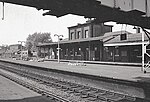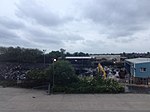Birmingham Railway Carriage and Wagon Company
1854 establishments in England1963 disestablishments in EnglandBirmingham Railway Carriage and Wagon CompanyBritish companies disestablished in 1963British companies established in 1854 ... and 7 more
Companies based in SmethwickDefunct companies based in Birmingham, West MidlandsManufacturing companies based in Birmingham, West MidlandsManufacturing companies disestablished in 1963Manufacturing companies established in 1854Rail transport in the West Midlands (county)Use British English from February 2017

The Birmingham Railway Carriage and Wagon Company (BRC&W) was a railway locomotive and carriage builder, founded in Birmingham, England and, for most of its existence, located at nearby Smethwick, with the factory divided by the boundary between the two places. The company was established in 1854.
Excerpt from the Wikipedia article Birmingham Railway Carriage and Wagon Company (License: CC BY-SA 3.0, Authors, Images).Birmingham Railway Carriage and Wagon Company
Middlemore Business Park, Birmingham Handsworth
Geographical coordinates (GPS) Address Nearby Places Show on map
Geographical coordinates (GPS)
| Latitude | Longitude |
|---|---|
| N 52.505277777778 ° | E -1.9608333333333 ° |
Address
Middlemore Business Park
Middlemore Business Park
B71 4LS Birmingham, Handsworth
England, United Kingdom
Open on Google Maps








